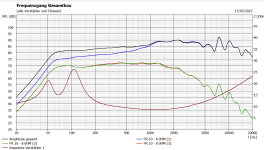It wouldn't so much be a driver that needs it, but a cabinet... unless we're talking about a driver which happens to have a certain natural response.
Cabinet, room, taste.
I have never had to add any direct BSC to any Alpair.
When i think Alpair and 1.5 way is use of a series connection and a big shunt cap across one.
http://www.planet10-hifi.com/downloads/Dual-Driver-Wiring.pdf
Am developing just such a box with 3 x Alpair 6.2p.
dave
I have never had to add any direct BSC to any Alpair.
When i think Alpair and 1.5 way is use of a series connection and a big shunt cap across one.
http://www.planet10-hifi.com/downloads/Dual-Driver-Wiring.pdf
Am developing just such a box with 3 x Alpair 6.2p.
dave
Last edited:
Not sure why, as the A6p has been OOP for some time now?Am developing just such a box with 3 x Alpair 6.2p.
jeff
Does anyone have a simulation of frequency response for this type of filter?
Still a work in progress:
dave
As you suspect and as Dave alluded, this offers no baffle compensation. It simply hands off to more drivers for the bass.Does anyone have a simulation of frequency response for this type of filter?
This is basically a series filter (instead of parallel which is more conventional).
Which is not always advisable because of the non-linear behavior of Le(X) as well as power compression (change in Re).
Although in this case it's probably fine 😀
One could do with a speaker less in a parallel filter design for BSC
the non-linear behavior of Le(X)
Yes, we ran into that. XO point should not be too close to the LF resonance.
XO point should be below thw quarter wavelength of the centre-to-centre, and above the bafflestep.
dave
Another problem is that Le actually shifts with higher cone excursion.Yes, we ran into that. XO point should not be too close to the LF resonance.
XO point should be below thw quarter wavelength of the centre-to-centre, and above the bafflestep.
dave
Unless this is stabilized with demodulation ring (copper ring) in the motor.
What happens if the two bass drivers are wired in parallel? And even more of them?
Does it help to get more output in the bass?
Does it help to get more output in the bass?
If we don't take the beaming effect into account, paralleling drivers ad up with 20*log(amount of drivers).
But this is for the entire (theoretical) frequency band.
You always need a low pass filter.
Finding a woofer with similar specs would also be an option.
But this is for the entire (theoretical) frequency band.
You always need a low pass filter.
Finding a woofer with similar specs would also be an option.
A nominal 1.8ohm impedance load 😉What happens if the two bass drivers are wired in parallel? And even more of them?
Theoretically +6dB relative to a single unit in the LF (+3dB for the doubled cone area & + 3dB for the doubled current draw).
Another problem is that Le actually shifts with higher cone excursion.
Unless this is stabilized with demodulation ring (copper ring) in the motor.
The Alpairs all have that.
dave
What happens if the two bass drivers are wired in parallel? And even more of them?
dave
I have been simulating this in Boxsim (just because it was quickest for me) and although the idea seems nice, it doesn't quite work so well unfortunately.
This is mostly because of how the attenuation works across all loads and therefor you don't get the +6dB you need at the lower frequencies. There is also quite some weird interaction happening in the impedance plot itself.
Also cost wise it doesn't make sense when the Le of the woofers is already very low.
This means a big capacitor. A simple inductor would be far more cost effective.
So I would just stick to the parallel circuit instead.
This is mostly because of how the attenuation works across all loads and therefor you don't get the +6dB you need at the lower frequencies. There is also quite some weird interaction happening in the impedance plot itself.
Also cost wise it doesn't make sense when the Le of the woofers is already very low.
This means a big capacitor. A simple inductor would be far more cost effective.
So I would just stick to the parallel circuit instead.
Attachments
Last edited:
This means a big capacitor. A simple inductor would be far more cost effective.
Yes, big cap, it says that in the picture.
These 2 solutions have completely different aims. Use an inductor and all of a sudden you have 6dB too much room response. Not the case for the series connection.
But usually neither is the goal, 2-3 dB of LF gain more useful.
dave
- Home
- Loudspeakers
- Full Range
- Which Alpair drivers, if any, need a BSC filter?


